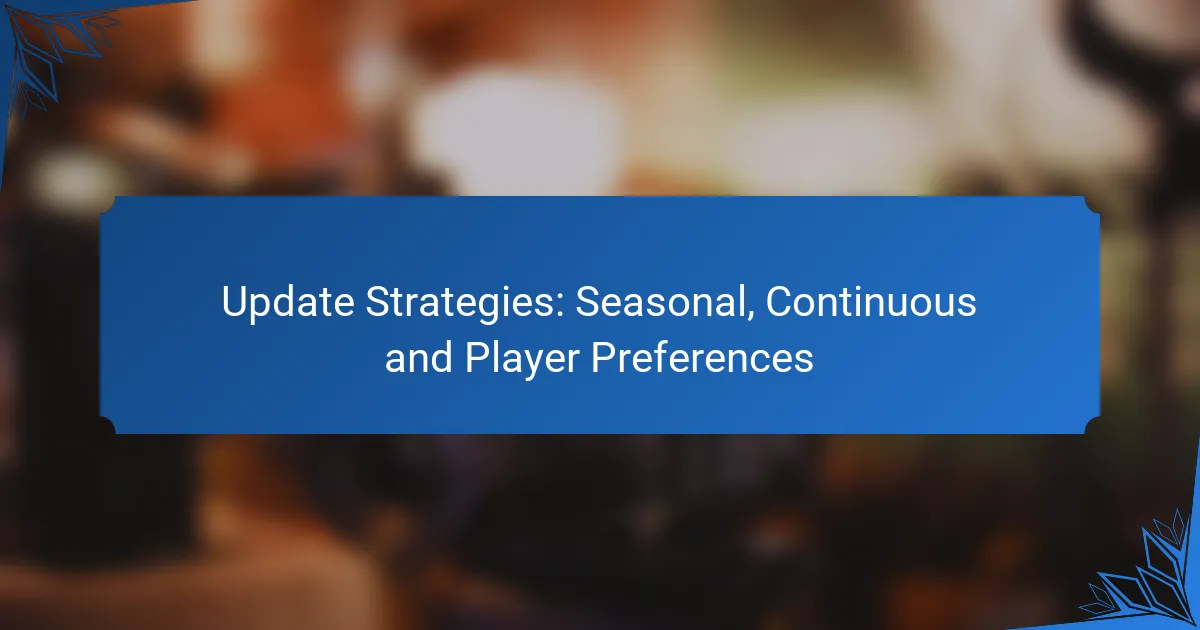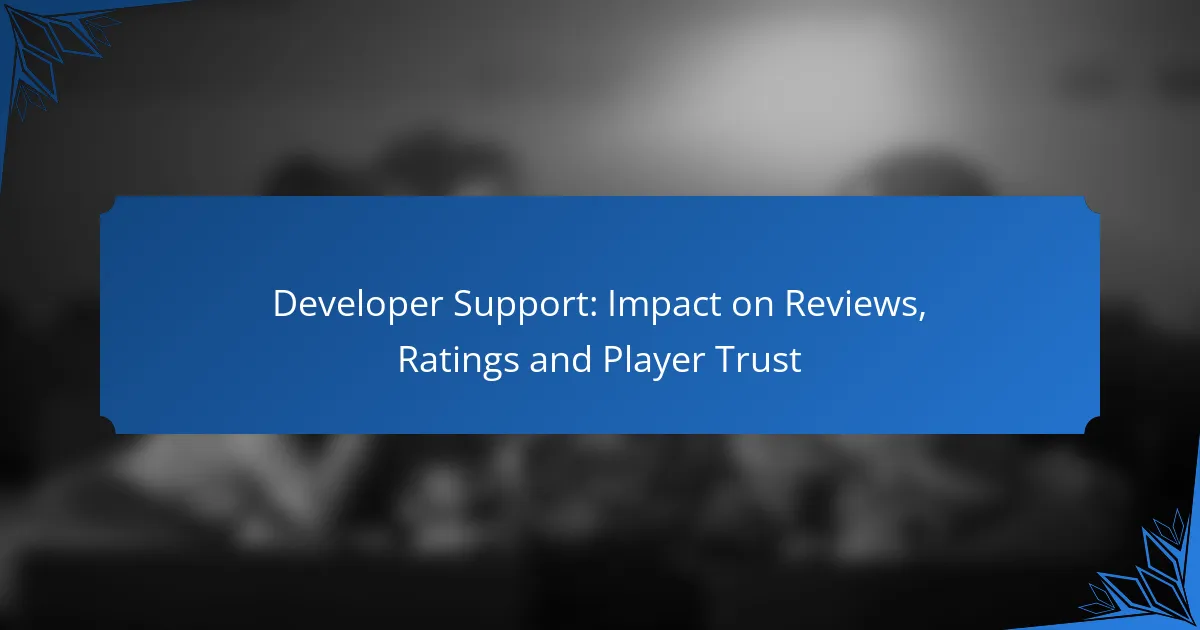Effective update strategies are crucial for maintaining player engagement in games, with seasonal updates, continuous improvements, and a focus on player preferences playing key roles. Seasonal updates introduce fresh content and events, while continuous updates ensure real-time enhancements and issue resolution. By understanding player demographics and feedback, developers can tailor their approaches to meet expectations and foster a vibrant gaming community.

What are the best update strategies for seasonal games?
The best update strategies for seasonal games include implementing seasonal content updates, event-driven updates, and player engagement tactics. These approaches help maintain player interest, enhance gameplay experiences, and encourage community participation.
Seasonal content updates
Seasonal content updates introduce new themes, challenges, and rewards that align with real-world seasons or holidays. For instance, a winter-themed update might feature snow-covered landscapes, festive quests, and exclusive items available for a limited time. This strategy can significantly boost player engagement and retention during specific periods.
When planning seasonal updates, consider the duration and frequency. Many games opt for quarterly updates, allowing players to anticipate new content while balancing development resources. Ensure that the updates feel fresh and relevant to the season to maximize their impact.
Event-driven updates
Event-driven updates are tied to specific in-game events or real-world occurrences, such as tournaments or anniversaries. These updates often include unique challenges, limited-time rewards, and special events that encourage players to log in and participate. For example, a game might host a Halloween event featuring spooky quests and themed items.
To effectively implement event-driven updates, create a clear timeline and communicate the details to players. Use countdowns and reminders to build anticipation, and consider offering exclusive rewards to incentivize participation. This approach can foster a sense of community and excitement among players.
Player engagement tactics
Player engagement tactics focus on maintaining ongoing interaction with the game, even outside of major updates. Techniques include regular communication through newsletters, social media, and in-game notifications, as well as community challenges and feedback surveys. These tactics help players feel valued and connected to the game.
Consider implementing a rewards system that recognizes player loyalty and participation. For instance, offering daily login bonuses or seasonal challenges can encourage players to return consistently. Additionally, actively responding to player feedback can help refine future updates and enhance overall satisfaction.
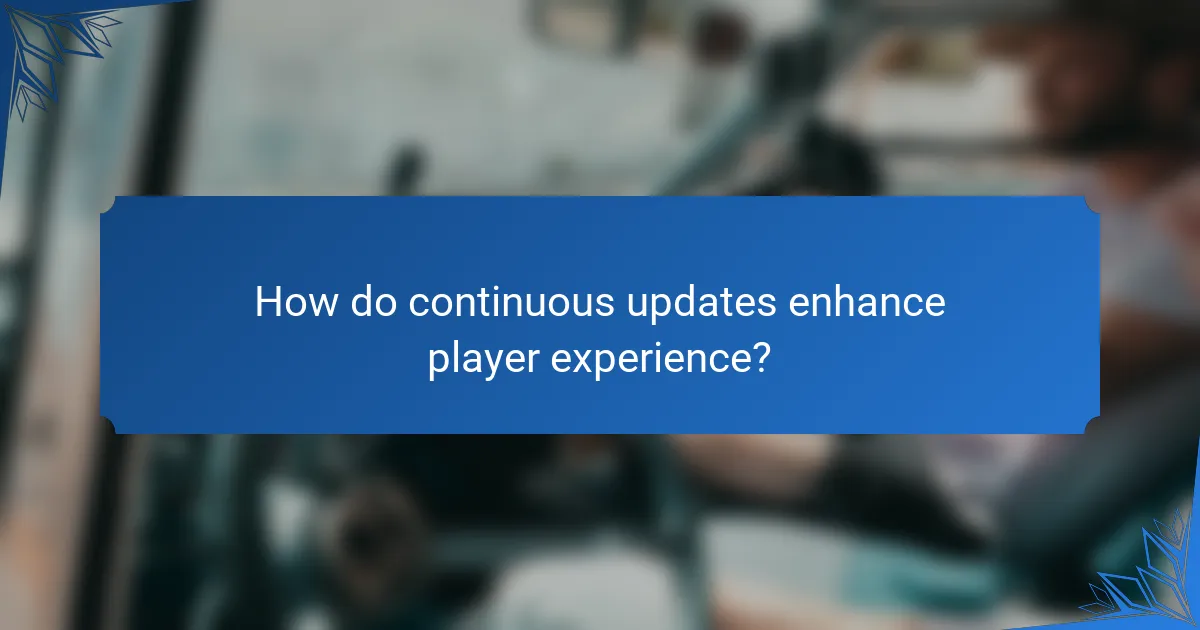
How do continuous updates enhance player experience?
Continuous updates significantly enhance player experience by providing fresh content and addressing issues in real-time. This approach keeps players engaged and ensures that the game evolves based on user preferences and technical needs.
Regular content additions
Regular content additions, such as new levels, characters, or game modes, keep the gameplay experience dynamic. By introducing updates every few weeks or months, developers can maintain player interest and encourage ongoing participation. For example, seasonal events can attract players back to the game, offering limited-time rewards and challenges.
To maximize impact, developers should consider player demographics and preferences when planning content. Tailoring updates to specific player segments can lead to higher engagement rates and satisfaction.
Bug fixes and performance improvements
Addressing bugs and enhancing performance through continuous updates is crucial for maintaining a smooth gaming experience. Regular patches can resolve issues that may frustrate players, such as crashes or lag, which can occur in games with complex graphics or online features.
Developers should prioritize fixes based on player feedback and the severity of issues. Implementing a system for players to report bugs can streamline this process and ensure that critical problems are addressed promptly.
Player feedback integration
Integrating player feedback into continuous updates fosters a sense of community and ownership among players. By actively soliciting opinions through surveys or forums, developers can gain insights into what players enjoy and what needs improvement.
To effectively incorporate feedback, developers should communicate changes made based on player suggestions. This transparency not only builds trust but also encourages players to continue sharing their thoughts, creating a cycle of improvement and engagement.
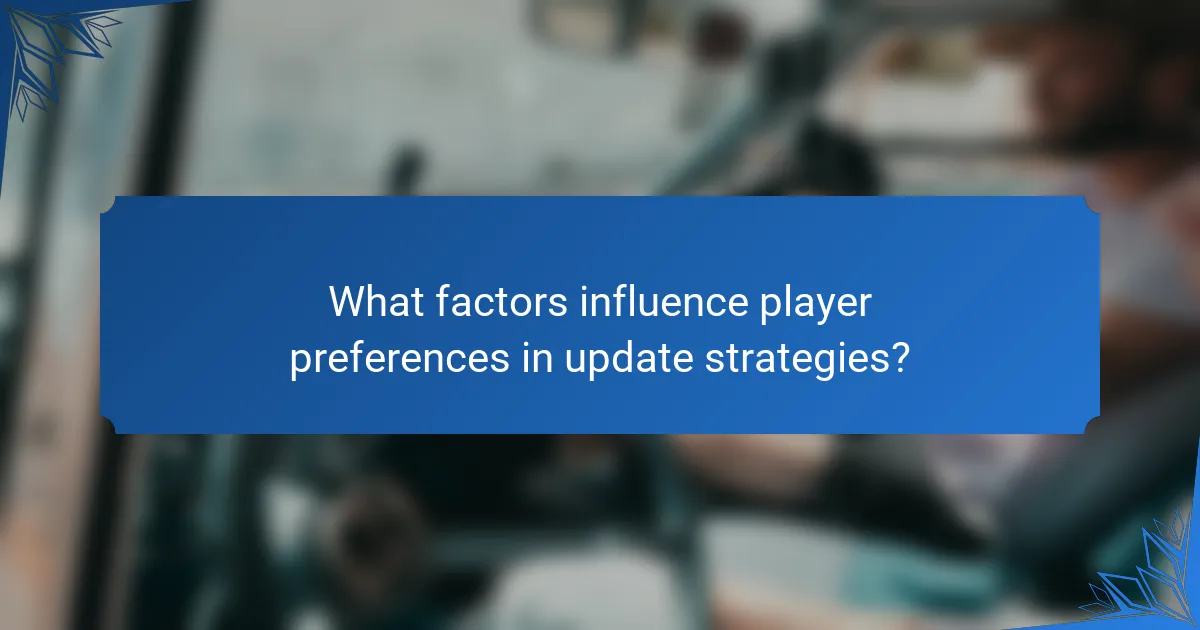
What factors influence player preferences in update strategies?
Player preferences in update strategies are shaped by various factors, including demographics, game genres, and community feedback. Understanding these elements can help developers tailor their update approaches to better meet player expectations and enhance engagement.
Player demographics
Player demographics, such as age, gender, and geographic location, significantly influence update preferences. For instance, younger players may favor frequent updates with new content, while older players might prefer stability and fewer changes. Additionally, cultural factors can affect how players perceive and respond to updates.
Developers should analyze their player base to identify key demographic trends. Surveys and analytics can provide insights into what different groups value in update strategies, allowing for more targeted approaches.
Game genre trends
The genre of a game plays a crucial role in determining player preferences for updates. For example, multiplayer online battle arena (MOBA) games often require regular updates to maintain balance and introduce new characters, while single-player role-playing games (RPGs) may benefit from less frequent, more substantial content expansions.
Staying informed about genre-specific trends can guide developers in choosing the right update frequency and content type. Engaging with similar games and their communities can also provide valuable insights into successful update strategies.
Community feedback
Community feedback is essential for understanding player preferences regarding updates. Players often express their desires and concerns through forums, social media, and in-game surveys. Actively listening to this feedback can help developers prioritize features and changes that resonate with their audience.
Implementing a feedback loop, where players see their suggestions reflected in updates, can foster a sense of ownership and loyalty. Developers should regularly communicate with their community to keep them informed about upcoming changes and gather ongoing input.

What are the prerequisites for effective update strategies?
Effective update strategies require a deep understanding of player preferences, robust data analytics, and appropriate resource allocation. These elements ensure that updates resonate with players and enhance their overall experience.
Understanding player behavior
Understanding player behavior is crucial for tailoring updates that meet user expectations. This involves analyzing how players interact with games, including their engagement patterns, preferences, and feedback. Observing these behaviors can help identify trends and inform the timing and content of updates.
For instance, if data shows that players tend to engage more during weekends, scheduling updates for Fridays can maximize visibility and participation. Additionally, incorporating player feedback into update planning can foster a sense of community and loyalty.
Data analytics tools
Utilizing data analytics tools is essential for gathering insights into player behavior and preferences. Tools like Google Analytics, Mixpanel, or in-game telemetry systems can provide valuable metrics on player engagement, retention, and spending. These insights can guide decisions on what features or content to prioritize in updates.
When selecting analytics tools, consider factors such as ease of integration, real-time data capabilities, and the ability to segment player demographics. Regularly reviewing this data can help refine update strategies and ensure they align with player interests.
Resource allocation
Effective resource allocation is vital for executing update strategies successfully. This involves distributing time, budget, and personnel effectively to maximize the impact of updates. Prioritizing high-impact features or content based on player feedback can lead to more successful updates.
For example, if a significant portion of the player base requests a specific feature, dedicating resources to develop that feature can yield a higher return on investment. Establishing a clear roadmap and timeline for updates can also help ensure that resources are used efficiently and effectively.
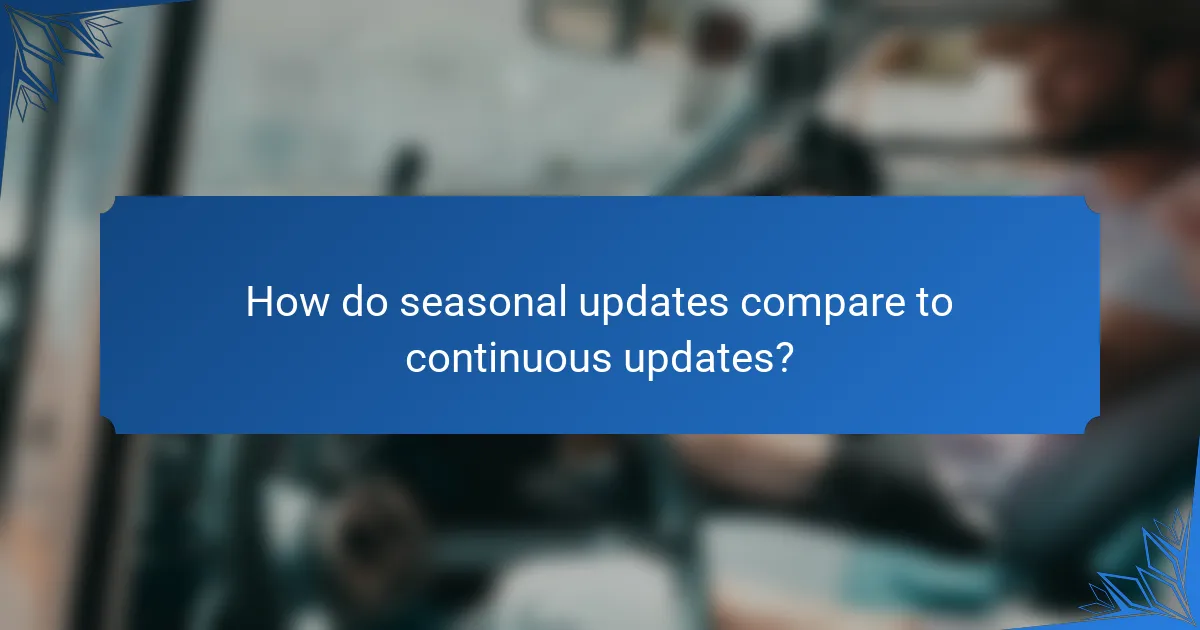
How do seasonal updates compare to continuous updates?
Seasonal updates introduce significant changes at specific times, while continuous updates provide ongoing, incremental improvements. Each approach has distinct advantages and challenges that can impact player engagement and satisfaction.
Engagement levels
Seasonal updates often generate spikes in player engagement due to the anticipation and excitement surrounding new content. For example, a game might see a surge in activity during holiday-themed events, attracting both returning and new players.
In contrast, continuous updates maintain a steady level of engagement by regularly introducing new features or content. This approach can keep players invested over time, as they know there will always be something new to explore.
Content freshness
Seasonal updates can refresh a game’s content dramatically, offering themed experiences that feel unique and time-sensitive. This can create a sense of urgency for players to participate before the content is removed.
Continuous updates, however, ensure that content remains relevant and fresh on an ongoing basis. By gradually rolling out new features, developers can respond to player feedback and adapt the game to evolving preferences, keeping the experience dynamic.
Player retention rates
Seasonal updates can boost player retention temporarily, as players return to experience the new content. However, if the updates are infrequent, players may lose interest during downtime between seasons.
Continuous updates typically foster higher long-term retention rates, as players are less likely to abandon a game that consistently evolves. Regular updates can create a habit among players, encouraging them to log in frequently to see what’s new.

What are the emerging trends in game update strategies?
Emerging trends in game update strategies include a shift towards AI-driven personalization, seasonal updates, and continuous integration based on player preferences. These strategies aim to enhance player engagement and retention by tailoring experiences to individual user behaviors and preferences.
AI-driven personalization
AI-driven personalization leverages data analytics to customize game experiences for individual players. By analyzing player behavior, preferences, and in-game actions, developers can create tailored content that resonates with users, increasing satisfaction and engagement.
Implementing AI-driven personalization involves collecting data on player interactions and using algorithms to identify patterns. For instance, if a player frequently engages with a specific game mode, the system can prioritize updates or events related to that mode. This approach can lead to higher retention rates, as players feel more connected to the game.
However, developers should be cautious about privacy concerns and ensure compliance with data protection regulations. Transparency about data usage and providing players with control over their data can foster trust and enhance the overall gaming experience.
